STEINBERG HALion Symphonic Orchestra Instruction Manual v1.5 [fr]
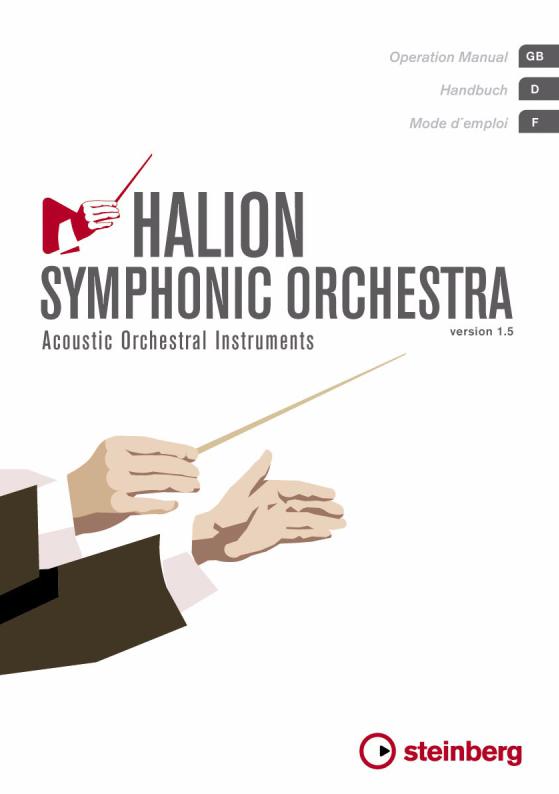
The information in this document is subject to change without notice and does not represent a commitment on the part of Steinberg Media Technologies GmbH. The software described by this document is subject to a License Agreement and may not be copied to other media. No part of this publication may be copied, reproduced or otherwise transmitted or recorded, for any purpose, without prior written permission by Steinberg Media Technologies GmbH.
All product and company names are ™ or ® trademarks of their respective owners. Windows XP is a trademark of Microsoft Corporation. Windows Vista is either a registered trademark or trademark of Microsoft Corporation in the United States and/or other countries. The Mac logo is a trademark used under license. Macintosh is a registered trademark. Mac OS X is a registered trademark. Cakewalk SONAR is a registered trademark of Twelve Tone Systems. ReWire is a trademark of Propellerhead Software AB. Logic is a trademark of Apple Computer, Inc. registered in the U.S. and other countries.
Version: 1.5
© Steinberg Media Technologies GmbH, 2007.
All rights reserved.
HALion Symphonic Orchestra
2

Table of Contents
5 |
Welcome |
7 |
Installation |
7The Steinberg Key
8System Requirements (PC version)
8Installation (PC version)
9System Requirements (Mac version)
10Installation (Mac version)
11Activating the Steinberg Key
12About HALion Content Converter
13Register your software!
14Preparations
14Setting up HALion Symphonic Orchestra as a VST Instrument in Cubase
16 Setting up HALion Symphonic Orchestra as a DXi2 Synth
18Using HALion Symphonic Orchestra in an AU compatible application
19HALion Symphonic Orchestra stand-alone and ReWire
23HALion Symphonic Orchestra details
23About programs, banks and .hsb files
24The 16 program slots
25Sound editing
30Global controls
31Global Commands context menu
32The Keyboard
34The Disk LED
34The RAM Save button
35Performance issues
37Content Description
37Using the content in HALion
37Upgrading from HALion String Edition
37Expression and control
38The main program types
40Instrument-specific programs
42Articulations in programs
50Enhancing expressiveness and realism
54Expression controls overview
55Content structure and program reference
ENGLISH
HALion Symphonic Orchestra
3
55 |
Demo Content |
55 |
Program reference |
59 |
Programs |
90 |
Tutorial: Arranging orchestra sections |
90 |
Introduction of instruments |
90 |
Score order |
92 |
Common Articulations |
94Transposing instruments
95Woodwinds
101 |
Brass |
105 |
Percussion |
109 |
Strings |
113 |
Hierarchy and harmonic weight |
113 |
Groups |
113Instruments
114Chords
117Reconstructing a score with HALion Symphonic Orchestra
117The first page
118Choosing the right programs in HALion Symphonic Orchestra
119Distributing instruments
122 Fine tuning and mixing techniques
122 Literature
HALion Symphonic Orchestra
4

Welcome
HALion Symphonic Orchestra is the complete, easy-to-use solution for any musician and composer looking for the vast sonic palette of an entire orchestra. You can create stunningly full orchestral masterpieces, ultra-expressive solo lines as well as beautiful smaller arrangements – with all the advantages of modern computer-based production environments.
Capturing the pure emotive power, expressiveness and sheer sonic range of an entire orchestra, HALion Symphonic Orchestra offers an enormous wealth of outstanding sound content including solo and ensemble double basses, cellos, violas and violins, brass, woodwind and percussion instruments. Each of these instruments in turn offers a wealth of expressive playing styles and articulations. The enormous 27GB library is as flexible as it is accessible, ideally suited not only to classical music but also Pop, Rock, HipHop, R’n’B and any other contemporary style.
HALion Symphonic Orchestra has been crafted to offer both exquisite playability and stunning realism. Offering the advanced features of Steinberg’s award-winning HALion 3 sampling engine, HALion Symphonic Orchestra is so much more than just another sample library, providing an exceptional virtual instrument with the quality, variety and usability needed to create arrangements on a truly orchestral scale.
Enjoy playing with your new orchestra!
Your Steinberg Team
ENGLISH
HALion Symphonic Orchestra
5
About the producer of HALion Symphonic Orchestra — Claudius Brüse
Born in Germany, Claudius Brüse started his musical career in 1978 in Seattle with a scholarship from Cornish Institute. Back in Germany, he studied jazz composition and arrangement in Cologne, followed by studying composition at the Folkwangschule in Essen, where he graduated in electronic and computer composition in 1984. Over the years, he has composed a lot of contemporary concert music, ranging from chamber music to orchestral works, and a multitude of film and commercial music, including documentaries, television work and feature films on both sides of the Atlantic – frequently travelling between his two homes in Cologne and Los Angeles. He co-developed the Waldorf Wave synthesizer and has written numerous magazine articles.
Over the years, Claudius and Steinberg have collaborated on many projects, e.g. the VST instruments “The Grand“ and “HALion String Edition”.
HALion Symphonic Orchestra shows Claudius’ handwriting all over the place: The typical accuracy in the reproduction of the highly sensitive acoustic instrument sound, superior sound quality and transparency, perfection down to the tiniest detail and – last but not least – an unrivalled feel for playability and control.
HALion Symphonic Orchestra
6

Installation
The Steinberg Key
ENGLISH
Please read the following section before installing the HALion Symphonic Orchestra software.
Included with the HALion Symphonic Orchestra package, you will find an activation code for the Steinberg Key (sometimes referred to as a “dongle”), a hardware copy protection device that is part of the HALion Symphonic Orchestra copy protection scheme. HALion Symphonic Orchestra will not run if there is no Steinberg Key and if this key hasn’t been properly activated. You can either separately purchase a new Steinberg Key for use with HALion Symphonic Orchestra, or use a key previously bought for use with a different Steinberg application.
The Steinberg Key
The Steinberg Key is, in fact, a little computer on which your Steinberg software licenses are stored. All hardware-protected Steinberg products use the same type of key, and you can store more than one license on one key. Also, licenses can (within certain limits) be transferred between keys – which is helpful, e.g. if you want to sell a piece of software.
•If you have a Windows PC, the installation program may initiate a restart of Windows after installation of the key drivers and the program software. After the restart, make sure the key is plugged into the USB port to proceed with the key activation.
•If you have an Apple Macintosh computer, there will be no automatic restart. Be sure to read the information regarding the Steinberg Key that is displayed during the installation process.
HALion Symphonic Orchestra
7

If you already own a Steinberg Key (e.g. for Cubase or Nuendo), you can load your HALion Symphonic Orchestra license onto that one, using the activation code supplied with HALion Symphonic Orchestra. This way you need only one USB key for both your host application and HALion Symphonic Orchestra (see below).
System Requirements (PC version)
To be able to use HALion Symphonic Orchestra you will need at least:
•Windows XP (Home or Professional)/Windows Vista Ultimate or Home Premium
•Pentium/AMD Athlon 2GHz
•1GB RAM (2GB recommended)
•27GB of free disk space
•Host application compatible with VST 2.0, DXi2 (32bit version only) or ReWire
•Windows MME compatible audio hardware (ASIO compatible audio card recommended)
•Steinberg Key and USB component connector
•DVD ROM drive for installation
•Internet connection for activation of the Steinberg Key.
Please also observe the system requirements of your host application! Check the Steinberg web site for recommendations on how to configure your system.
Installation (PC version)
Proceed as follows to install HALion Symphonic Orchestra:
1.Insert the HALion Symphonic Orchestra installation DVD into your DVD drive, launch the Explorer or open the “My Computer” window and double-click on the symbol for the DVD drive that holds the HALion Symphonic Orchestra DVD.
If autostart is activated, the DVD contents will automatically open in a new window.
2.Double-click on the HALion Symphonic Orchestra Installer symbol to launch the installation program and follow the instructions on screen.
HALion Symphonic Orchestra
8
3. |
As part of the installation process you will be asked if you wish to in- |
ENGLISH |
|
||
|
stall the HALion Symphonic Orchestra audio files. |
|
|
Activate the radio button for the desired option, and specify a path to a location on |
|
|
|
|
|
your hard disk. Note that the content installation will proceed after installation of the |
|
|
program software and the key activation. See below. |
|
4. |
After installation of the software, the installation program will initiate a |
|
|
restart of your computer. |
|
5. |
If you chose to install the content files as part of the installation, you |
|
|
must insert the corresponding DVDs once the Steinberg Key activa- |
|
|
tion has finished. |
|
•If you decide to not install the content during installation of the program software, and simply copy the desired content files from the DVDs at a later point in time, you MUST use the Locate Content function to show HALion Symphonic Orchestra where to find the audio files.
Once the Steinberg Key is activated and the content files are available on your hard disk, you can start using HALion Symphonic Orchestra.
Content installation for Vista 64 bit
If you install the Vista 64 bit version of HALion Symphonic Orchestra, the program content will not be installed automatically. Follow the instructions displayed on screen during the installation process to install the content.
System Requirements (Mac version)
To be able to use HALion Symphonic Orchestra you will need at least:
•Mac OSX 10.4
•Power Mac G5 2GHz/Intel CoreSolo 1.5GHz
•1GB RAM (2GB recommended)
•CoreAudio compatible audio hardware
•27GB of free disk space
•For using as plug-in or ReWire slave, a VST 2.0, AU (tested with Logic 8) or ReWire compatible host is required.
•Steinberg Key and USB component connector
•DVD ROM drive for installation
•Internet connection for activation of the Steinberg Key.
HALion Symphonic Orchestra
9

Please also observe the system requirements of your host application! Check the Steinberg web site for recommendations on how to configure your system.
Installation (Mac version)
Proceed as follows to install HALion Symphonic Orchestra:
1.Quit all other applications so that you return to the Finder. Disable any system activity monitoring software or extension, in particular anti-vi- rus software. Now, insert the HALion Symphonic Orchestra installation DVD into the computer’s DVD drive.
2.If it doesn’t open automatically, double-click the HALion Symphonic Orchestra icon to open the DVD contents window.
3.Double-click on the HALion Symphonic Orchestra Installer symbol to load the installation software. Follow the instructions on screen.
4.When the program software has been installed, proceed with the key activation (see below).
Installing the content (Mac)
To install the HALion Symphonic Orchestra audio content, proceed as follows:
1.Insert DVD 1 into your DVD drive.
2.Decide which content files you wish to install and launch the appropriate content installer.
Specify a path to a location on your hard disk, and click Choose.
3.A status bar is displayed to show the progress of the installation process.
Once the files have been copied, remove DVD 1 from the drive, and insert the next DVD. Which one you need depends on which version of the audio files you are installing. Again, launch the desired content installer, specify a path, and click Choose.
4.Repeat these steps until all the content files you wish to use have been copied to your hard disk.
HALion Symphonic Orchestra
10

• You can also simply copy the desired content files from the DVDs to a |
ENGLISH |
|
|
location on your hard disk. In this case, however, you MUST use the |
|
Locate Content function to show HALion Symphonic Orchestra |
|
|
|
where to find the audio files. |
|
Activating the Steinberg Key
Your Steinberg Key does not yet contain the license required for HALion Symphonic Orchestra. You must download this license before you can launch HALion Symphonic Orchestra!
Use the activation code supplied with the program in order to download the valid HALion Symphonic Orchestra license to your Steinberg Key. This process is the same both for existing and new keys. Proceed as follows:
1.After installation, make sure that your Steinberg Key is plugged into the USB port(on a Windows PC, you may have to restart your computer first).
If you are unsure of which port this is, consult the documentation of your computer.
2.If this is the first time a copy protection device is plugged in, it will be registered as a new hardware device. On a Mac, drivers are found automatically without further user interaction. Windows may display a dialog asking you whether you would like to find drivers for the device manually or automatically.
Under Windows, choose to find drivers automatically. The dialog closes, and you may have to reboot your computer.
3.Make sure that your computer has a working internet connection.
License download is made “online”. If the computer on which you installed HALion Symphonic Orchestra is not connected to the internet, it is possible to use another computer for the online connection – proceed with the steps below and see the help for the License Control Center application.
4.Launch the “License Control Center” application (found in the Windows Start menu under “Syncrosoft” or in the Macintosh Applications folder).
This application allows you to view your Steinberg Keys and load or transfer licenses.
HALion Symphonic Orchestra
11
5.Use the License Control Center “Wizard” function and the activation code supplied with HALion Symphonic Orchestra to download the license for HALion Symphonic Orchestra to your Key. Simply follow the on-screen instructions.
If you are uncertain about how to proceed, consult the help for LCC.
When the activation process is completed, you are ready to launch HALion Symphonic Orchestra!
About HALion Content Converter
The HALion Content Converter is a utility for the fast conversion of HSB files to a new high-performance version. Converted HSB files allow for faster reading by the latest version of HALion Symphonic Orchestra.
Please note:
•The HALion Content Converter will place the converted files in a location of your choice. The older versions of the HSB files remain at their previous location, but will be renamed (“.bak” is appended to the file name). Use the Locate Content function of HALion Symphonic Orchestra to show the program where to find the converted files.
•To be able to rename the older versions of the HSB files, these must not be located in a read-only location!
•Since the old versions of your HSB files are not automatically removed, your content will require twice as much space as before.
You can of course remove the backup versions after conversion.
•Converted HSB files cannot be read by any previous version of HALion Symphonic Orchestra.
Note that using the Locate Content function to find both converted and unconverted content may lead to unpredictable results and is therefore not recommended.
Proceed as follows:
1.Place the HALionContentConverter.exe file in a location of your choice on your computer and double-click to launch.
2.When the HALion Content Converter window is open, drag the HSB files you wish to convert into the window.
HALion Symphonic Orchestra
12
3. A File dialog is displayed. In this dialog, specify the location in which |
ENGLISH |
|
|
the converted HSB files should be stored, and click OK. |
|
The conversion is started. Depending on the size and amount of the |
|
|
|
HSB files to be converted, the process may take some time. |
|
Register your software!
Please fill out and send in the registration card that you have received with your software package. By doing so you are entitled to technical support and kept aware of updates and other news regarding HALion Symphonic Orchestra.
HALion Symphonic Orchestra
13
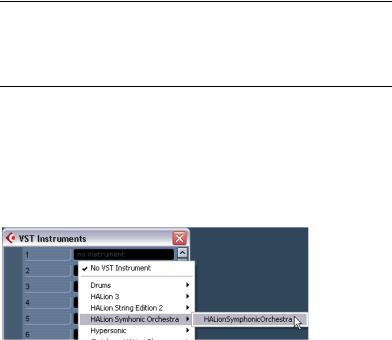
Preparations
The following sections describe how to set up HALion Symphonic Orchestra for use with different interface formats.
Setting up HALion Symphonic Orchestra as a VST Instrument in Cubase
The following information refers to the use of HALion Symphonic Orchestra within Cubase. We assume that you have correctly set up both Cubase and your MIDI and audio hardware. Should you wish to use HALion Symphonic Orchestra within another VST host application such as Nuendo, please refer to its documentation.
Proceed as follows to activate HALion Symphonic Orchestra:
1.Make sure that Cubase receives MIDI data that you generate with your external MIDI master keyboard.
2.In Cubase, open the “VST Instruments” window from the Devices menu, and select “HALion Symphonic Orchestra” from the pop-up menu of a free VST Instrument slot.
3.Clicking the “Power” button in the rack will activate/deactivate HALion Symphonic Orchestra.
By default this is automatically activated when a VST Instrument is loaded.
HALion Symphonic Orchestra
14
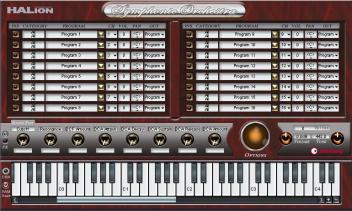
4. Click on the “Edit” button (“e”) to open the HALion Symphonic Or- |
ENGLISH |
|
|
chestra window. |
|
|
|
The HALion Symphonic Orchestra window.
5.In Cubase, select a MIDI track and set its output setting to “HALion Symphonic Orchestra”. Make sure that the MIDI track input is set to “All MIDI Inputs” or to the MIDI track to which your keyboard is connected.
This way, HALion Symphonic Orchestra will receive MIDI data from the selected track.
•HALion Symphonic Orchestra receives MIDI data in 16 channel multimode. It is therefore not necessary to assign a specific MIDI receive channel in HALion Symphonic Orchestra.
However, you should make sure that the currently selected Cubase track is set to the MIDI channel on which HALion Symphonic Orchestra is to receive MIDI data.
When set, you are ready to load programs and start using HALion Symphonic Orchestra!
HALion Symphonic Orchestra
15
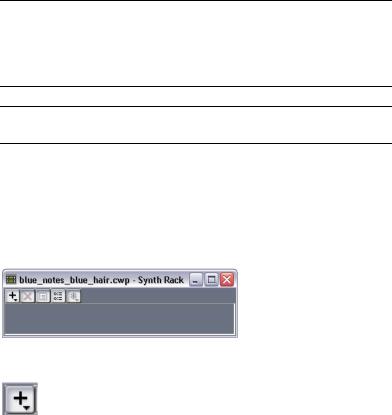
Setting up HALion Symphonic Orchestra as a DXi2 Synth
The following information refers to the use of HALion Symphonic Orchestra within Cakewalk SONAR. We assume that you have correctly set up both SONAR and your MIDI and audio hardware. Should you wish to use HALion Symphonic Orchestra within another DXi2 compatible host application, please refer to its documentation.
Note that DXi support is only available for the 32bit version of HALion Symphonic Orchestra.
Proceed as follows to activate HALion Symphonic Orchestra:
1.Make sure that SONAR receives MIDI data that you generate with your external MIDI master keyboard. You can check this visually with the “MIDI In/Out Activity” tray icon.
2.In SONAR, open the “Synth Rack” window from the View menu.
3. Click the Insert button.
The Insert button in the Synth Rack window.
HALion Symphonic Orchestra
16
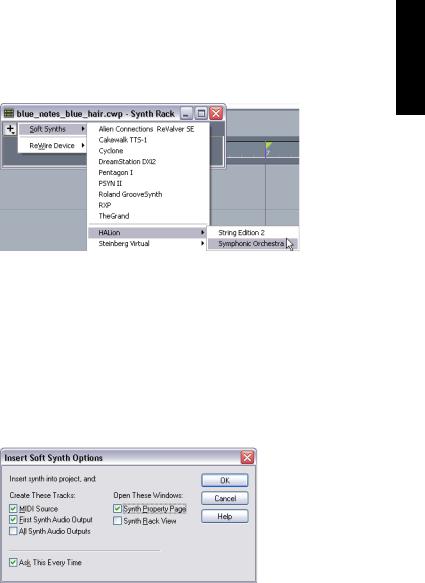
4. In the Soft Synth submenu, select “HALion Symphonic Orchestra”.
ENGLISH
5.By default, the “Insert Soft Synth Options” dialog appears. To create one MIDI track and connect an audio track to the outputs 1 and 2 of HALion Symphonic Orchestra, activate the options “MIDI Source” and “First Synth Audio Output”. To create all available HALion Symphonic Orchestra outputs, activate “All Synth Audio Outputs”.
Note that an output routing scheme was used when programming the various instrument groups of HALion Symphonic Orchestra. Make sure that you connect all outputs of your DXi application during setup, if you wish to use more than one output during mixing. If you only connect the first audio output, you will save system resources. However, make sure to manually set the output in the Out pop-up for the program slot in HALion Symphonic Orchestra to this output, otherwise you may not hear anything.
HALion Symphonic Orchestra
17

6.Clicking the “Connection State” button in the Synth Rack will activate/ deactivate HALion Symphonic Orchestra. By default this is automatically activated when DXi SoftSynths are loaded.
7.Double-click on the “HALion Symphonic Orchestra” entry or click the “Synth Properties” button in the toolbar of the Synth Rack to open the HALion Symphonic Orchestra window.
The Synth Properties button in the Synth Rack window.
8.In SONAR, select the previously created MIDI track “HALion Symphonic Orchestra”. HALion Symphonic Orchestra will now receive MIDI data from the selected track. Make sure that the MIDI track input is set to All or to the MIDI track to which your keyboard is connected.
HALion Symphonic Orchestra receives MIDI data in 16 channel multi-mode. It is therefore not necessary to assign a specific MIDI receive channel in HALion Symphonic Orchestra. However, you should make sure that the currently selected SONAR track is set to the MIDI channel on which HALion Symphonic Orchestra is to receive MIDI data.
When set, you are ready to load programs and start using HALion Symphonic Orchestra!
Using HALion Symphonic Orchestra in an AU compatible application
You can use HALion Symphonic Orchestra in an AU host application (e.g. Logic).
The HALion Symphonic Orchestra AU version is installed in your AU plugins folder and lets HALion Symphonic Orchestra work in an AU environment – without any performance loss or incompatibilities.
HALion Symphonic Orchestra
18

For Logic Pro 7 proceed as follows:
1.Open the Track Mixer and choose the desired Instrument channel.
2.[Command]-click the I/O field and, in the pop-up menu that appears, choose either Multi-Channel or Stereo.
3.In the submenu that appears, select All Instruments and then HALion Symphonic Orchestra.
HALion Symphonic Orchestra is now loaded as an AU instrument.
ENGLISH
HALion Symphonic Orchestra stand-alone and ReWire
HALion Symphonic Orchestra can be used as a stand-alone application, independently of any host application. This makes it possible to use HALion Symphonic Orchestra in sequencer applications that do not support one of the provided plug-in formats of HALion Symphonic Orchestra (i.e. VST, DXi and AU), but allow for data exchange using ReWire.
Note that to use the ReWire functionality, the corresponding ReWire files must be installed. If you don’t have these files already, you can download them from www.propellerheads.se.
ReWire2 is a special protocol for streaming audio and MIDI data between two computer applications. When using ReWire, the order in which you launch and quit the two programs is very important, as the first audio application launched will capture the audio card resources.
Proceed as follows:
1.First, launch the sequencer application you wish to use (e.g. Ableton Live, ProTools).
If your sequencer supports ReWire, it will provide a way to assign audio and MIDI channels for the exchange of data. See the documentation of your sequencer application for details.
2.Now, launch HALion Symphonic Orchestra as a stand-alone application.
You can launch the program just like any other application on your computer through the Start menu or desktop icon (Win) or by double-clicking the application symbol in the Applications folder (Mac). You can also double-click the HALion Symphonic Orchestra program file in the installation folder.
HALion Symphonic Orchestra
19

When you are using a Mac, note that after installation of HALion Symphonic Orchestra you have to launch the program in stand-alone mode once to activate the ReWire functionality.
When you now play a sample with HALion Symphonic Orchestra, the sound is streamed via ReWire to the assigned mixer channels in your host.
Note that you are now running two completely separate applications. When you save your sequencer project, this will include the overall channel and bus configuration, but none of the settings in HALion Symphonic Orchestra! To retain your HALion Symphonic Orchestra settings, choose the Save Bank command (in HALion Symphonic Orchestra either from the File menu or from the context menu). You may want to choose a file name that indicates that the file contains settings created for a particular sequencer project.
Similarly, when you re-open a project in your sequencer application and have launched HALion Symphonic Orchestra, use the Load Bank command in HALion Symphonic Orchestra to reload the HALion Symphonic Orchestra settings pertaining to this particular project.
If you are using the Vista 64-bit version of HALion Symphonic Orchestra, please note that ReWire is not supported.
HALion Symphonic Orchestra
20
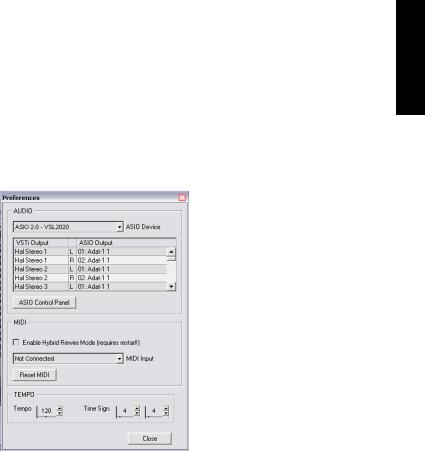
The Preferences dialog
When running HALion Symphonic Orchestra as a stand-alone application, you will find a Preferences item in the File menu in the top left corner of the application window (Win) or in the HALion Symphonic Orchestra menu in the top left of the display (Mac). When selected, a dialog with a number of options opens.
•This dialog is opened automatically when you launch HALion Symphonic Orchestra as a stand-alone application for the first time.
•Select an audio card driver from the ASIO Device pop-up.
•In the table below the ASIO device pop-up, click one of the entries in the ASIO Output column to change the assignment of virtual outputs of your VST Instrument to the physical outputs on your audio hardware.
Click the ASIO Control Panel button to open a dialog with advanced settings for your ASIO device.
ENGLISH
HALion Symphonic Orchestra
21
•When the “Enable Hybrid Rewire Mode (requires restart!)” option is activated (it is deactivated by default), you will directly access the system MIDI ports while in ReWire slave mode. Incoming MIDI data from the selected system port will be merged with the MIDI input from the host sequencer received via ReWire.
Note that when you change this setting you must restart HALion Symphonic Orchestra in stand-alone mode for the change to take effect.
•Use the MIDI Input pop-up to specify a MIDI input. Click the Reset MIDI button to reset all MIDI controllers (this has the same effect as when pressing the Panic button on a MIDI keyboard).
If “emulated” MIDI ports are listed on the MIDI Input pop-up, note that there is a simple way to force HALion Symphonic Orchestra to list Windows MIDI ports: Create a file called “ignoreportfilter” (e.g. via a simple text editor, without specifying any file extension) and place this file in the same folder as the application .dll file.
•The Tempo and Time Signature fields provide HALion Symphonic Orchestra with tempo and time signature information.
In stand-alone mode, such information is not available from a host application.
The other items on the File menu (Save/Load Bank and Save/Load Program) of the standalone version of HALion Symphonic Orchestra are the same as on the VSTi’s context menu. The “Save as Default Bank” option allows you to save the current bank as the bank to be loaded every time you open HALion Symphonic Orchestra.
HALion Symphonic Orchestra
22

HALion Symphonic Orchestra details
About programs, banks and .hsb files
ENGLISH
HALion Symphonic Orchestra plays back the samples of the content files supplied with your HALion Symphonic Orchestra DVDs. The content files are saved as HALion Sound Bank (.hsb) files. To play the content, HALion Symphonic Orchestra provides 16 so-called “program slots” which are used to access “programs”. The idea behind programs is outlined below:
•A Program file (.fxp) can be loaded into one of the 16 program slots. A program can contain any number of samples and all associated parameter settings.
To load a .fxp file, use the Load Program option, either from the pop-up menu opened by clicking the down-arrow of the program slot, or from the global context menu. You can also save changes made to a loaded program by using the Save Program option in the global context menu.
•When selecting the Load Program option, the loaded program will replace any program previously loaded in the current program slot.
•A Program Bank is used to load/save a particular program configuration.
If you want to save the current settings of HALion Symphonic Orchestra, including all programs and program settings currently loaded, select the Save Bank option from the global context menu.
•Program files and program bank files are lists of references to sample files, but do not contain these samples. The .hsb files, however, are “containers”, they contain both the programs and the samples referenced by these programs.
A .hsb file can contain up to 128 program files, which in turn can reference any number or samples.
•You cannot load a .hsb file directly. HALion Symphonic Orchestra needs to know the location of the .hsb file on your hard disk and then displays the programs contained in a located .hsb file in the list of programs.
See page 30 for a description of the Locate Content function. By selecting a program from the list in the Load Program pop-up menu it is loaded into the current program slot.
HALion Symphonic Orchestra
23
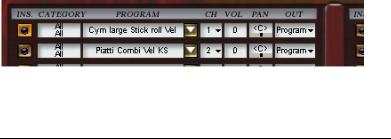
The 16 program slots
A program is loaded into one of the 16 program slots of HALion Symphonic Orchestra.
The first program slot in HALion Symphonic Orchestra.
The 16 program slots in HALion Symphonic Orchestra provide a number of settings.
Column |
Description |
Ins. |
Click here to select the corresponding program slot. |
Category |
The two category pop-ups are used as filter criteria when browsing for a |
|
particular program: when you want to load a new program into a pro- |
|
gram slot, you can set the Category pop-ups to limit the number of pro- |
|
grams displayed in the Load Program pop-up. Note that HSB files not |
|
containing programs matching the defined categories won’t be dis- |
|
played. See page 29. |
Program |
Click on the arrow to open the Load Program pop-up menu. In the pop- |
|
up, select Load Program to load a new program and replace any cur- |
|
rently loaded program. A file dialog is opened in which you can browse |
|
for .fxp files. You can also select a program to load from the list below |
|
the option. Note that the list is available only if you previously located a |
|
.hsb file for this slot, and that only .fxp files contained in the located .hsb |
|
file will be listed. |
Ch |
This pop-up menu allows you to select a MIDI channel for each program |
|
slot. By default, the 16 slots are logically assigned to the MIDI channels |
|
1-16. |
Vol |
To change the volume setting for a program slot, right-click (Win)/[Ctrl]- |
|
click (Mac) into the field and enter a new value. Note that this value af- |
|
fects the program slot, not the program. |
Pan |
To change the panorama setting for a program slot, click in this field. A |
|
slider appears allowing you to change the pan value. Note that this value |
|
affects the program slot, not the program. |
|
|
HALion Symphonic Orchestra
24
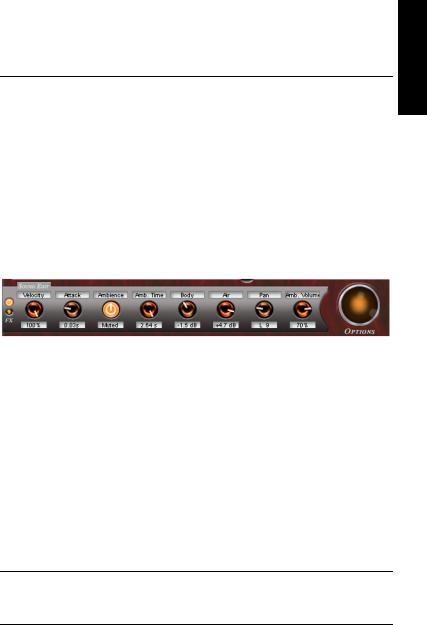
Column |
Description |
Out |
Clicking in the “Out” column for a channel slot opens the Output pop- |
|
up menu. When set to Program, the output information saved in the |
|
loaded program will be used to determine the output. You can also se- |
|
lect a specific output from the pop-up. Note that the outputs have been |
|
named to reflect the default output routing for each instrument group. |
|
|
ENGLISH
Sound editing
HALion Symphonic Orchestra is not limited to playing back programs “as they are” – you can change some of the program parameters and thus change the sound.
The Bypass button, the FX LED, the Q controls and the Options button.
Q controls
In the sound edit section below the program slots you find eight quick control knobs (or “Q controls”) allowing you to control up to eight parameters of the selected program.
To change a parameter setting, simply turn a knob. The label above the knob displays the name of the controlled parameter, the label below shows the current parameter value.
Which parameters are controlled by each Q control is defined in the
.fxp file. So, when you load a different .fxp file, the parameter names displayed above the Q controls may change.
Which parameters are assigned to the eight Q controls depends on the selected program, i.e. the assignment data is saved in each .fxp file. You cannot change the parameter assigned to a particular Q control.
The Bypass button and the FX LED
To the left of the Q controls you find a button and an LED referring to the use of HALion effects. The LED will light up whenever effects are used by the program. Use the Bypass button to bypass effects.
HALion Symphonic Orchestra
25

Player Options
The Player Options dialog opens when you click on the “ball” icon to the right of the Q controls.
The Player Options dialog
The settings in the Player Options dialog affect the overall behavior of HALion Symphonic Orchestra. These are described below.
Disk Streaming – Memory
•The setting for Preload into RAM determines how many seconds of each sample are loaded into RAM.
It should be set depending on the number of samples that you intend to use, and the amount of RAM you want to dedicate to HALion Symphonic Orchestra. The less RAM you assign, the more often HALion Symphonic Orchestra has to access the disk.
HALion Symphonic Orchestra
26
• The Cache Size value determines the total size of the cache, i.e. the |
ENGLISH |
|||
|
||||
|
amount of RAM available for disk streaming. |
|
||
|
The Disk LED in the bottom left corner of the HALion Symphonic Orchestra window will |
|
||
|
||||
|
light up red when samples cannot be loaded from disk in time. In such a case you can |
|
||
|
increase the cache size and/or the preload time of the samples. The bigger the cache |
|
||
|
size, the less disk streaming is required, however, a large value may mean that you are |
|
||
|
waisting RAM. You may want to experiment with this setting to find the optimum value |
|
||
|
for your system. |
|
||
• The cache is divided into “pages”. The “Cache Page Size” value de- |
|
|||
|
termines how big one of these pages is. |
|
||
|
I. e. it sets the size of the audio data read during one disk streaming operation. |
|
||
• “Memory max.” is the currrently set maximum amount of RAM available |
|
|||
|
for HALion Symphonic Orchestra. |
|
||
|
If you exceed this value, a warning message is displayed. |
|
||
• If you change any of the disk streaming settings, click Apply to apply |
|
|||
|
your changes, or Cancel to return to the previously set values. |
|
||
|
Note that [Ctrl]/[Command]-clicking the Apply button will save the current setting for |
|
||
|
Preload into RAM as a global default. |
|
||
|
See page 35 for more information on how to use these settings. |
|
||
Editing |
|
|
|
|
|
The Knob Modes determine the behavior of the HALion Symphonic |
|
||
|
Orchestra knobs: |
|
||
|
|
|
|
|
|
Option |
Description |
|
|
|
Circular |
To move a knob, you click on it and drag in a circular motion, much like |
|
|
|
|
turning a “real” knob. When you click anywhere along the knob’s edge, the |
|
|
|
|
setting is immediately changed. |
|
|
|
Relative |
Works like the “Circular” option, but clicking does not automatically |
|
|
|
Circular |
change the setting. This means you can make adjustments to the current |
|
|
|
|
setting by clicking anywhere on a knob and dragging, without having to |
|
|
|
|
click on the exact current position. |
|
|
|
Linear |
To move a knob, you click on it and drag up or down (or left or right) with the |
|
|
|
|
mouse button pressed – as if the knob was a vertical (or horizontal) slider. |
|
|
|
|
|
|
|
HALion Symphonic Orchestra 27

Crescendo Control
This controller is exclusive to Xfade and Xswitch programs.
In the Crescendo Control menu, you can select either of the four following controllers to control the crescendo function described later:
•Modulation wheel (CC 1)
•Breath Controller (CC 2)
•Foot Controller (CC 4)
•Expression (CC 11)
•To hear the Xfade programs, you have to move the set controller up after loading the program. This is because the controller’s initial value is 0.
This setting is global for all program slots in HALion Symphonic Orchestra. It is saved and loaded with your current project (when using HALion Symphonic Orchestra as a plug-in) or with bank files.
Quality
The Quality setting provides a way of balancing audio quality vs. conservation of computer power. The lower the Quality setting, the more voices are available. As a trade-off, sound quality is reduced.
The Resampling Quality pop-up provides three options: Fast, Good, and Best. Resampling removes anti-aliasing artifacts, which can be especially noticeable in high frequency areas. The higher the setting, the better these artifacts will be suppressed. The trade-off with higher settings is heavier CPU load. For samples with little high frequency content, you can safely use the “Fast” option. For programs that use different samples for every key (so that there is no resampling) you should always use the “Fast” option to conserve computing power.
This section also contains the Use Export Mode option. Some host applications do not provide loaded plug-ins with information about whether an audio mixdown (also called “bounce” or “freeze”) is made in realtime or in offline mode, which may result in incomplete exports. In such a case, activate the “Use export mode” option to allow for a complete export. Don’t forget to deselect this option again after the export is completed.
HALion Symphonic Orchestra
28

The MIDI controller list
The MIDI controller list is a two-column table. The column on the left shows entries for the eight Q control knobs, while the column on the right lists MIDI controllers assigned to each of the Q controls. Clicking in the MIDI controller column for a Q control entry opens a pop-up menu where you can pick one of the 128 MIDI controllers. There is also a “Not assigned” entry.
To assign a MIDI controller to a Q control so that you can remote control HALion Symphonic Orchestra using a connected MIDI device, proceed as follows:
1.Click in the MIDI controller column for the corresponding Q control and pick the desired MIDI controller.
For example, to remote control the first Q control knob using the modulation wheel on your MIDI keyboard, select “1. Modulation” from the pop-up menu.
2.Switch on the Learn button and move the control of your MIDI device.
In our example, you should now move the modulation wheel.
3.Switch off the Learn button.
Now the parameter assigned to the Quick Control is controlled by the selected slider or knob on the remote device!
Show Content by Category
ENGLISH
When you activate this option, all installed and located .hsb content will be shown in the Load Program pop-up menu, sorted by categories. When you deactivate this option, the Load Program pop-up shows the located .hsb files as collapsed folders, and you can browse the complete content of each .hsb file by opening the corresponding folder.
If you don’t want to see all programs contained in a .hsb file, you can still use the Category pop-ups in the program slot (see page 24).
About Content
This opens a window displaying information about the located content (.hsb) files of HALion Symphonic Orchestra. Use the pop-up menu at the top to select a .hsb file (you may also click one of the tabs at the bottom of the window to display the information for the corresponding
.hsb). The window displays the name, short name, manufacturer, manufacturer web site, and the path of the selected file.
HALion Symphonic Orchestra
29

Locate Content
The Locate Content function is used to “show” HALion Symphonic Orchestra where the .hsb files are stored. Once the content has been located, it is displayed as a list in the Load Program pop-up menu.
To use the Locate Content feature, proceed as follows:
1.In the Player Options dialog, select “Locate content…”.
A file dialog appears. By default, the function looks for .hsb files.
2.Locate and select the desired file(s) and click “Open”.
When you now open the Load Program pop-up menu, the programs contained in the located .hsb files are displayed in the list and can be used in HALion Symphonic Orchestra.
Note that when you install new content files (.hsb) on your hard disk, or when you move installed content, or when you chose not to install the content during installation of the program software, but copied it from the DVDs at a later point in time, you MUST use Locate Content to make this moved/new content available in HALion Symphonic Orchestra.
•When your content is located on an external hard drive, you may find that switching off this external device will cause HALion Symphonic Orchestra to loose all location information referring to this device.
Therefore, always make sure that an external drive with located content on it is up and running before you launch HALion Symphonic Orchestra. Otherwise, you will have to use Locate Content again.
Global controls
Master Tune/Volume settings/Voice number indicator
HALion Symphonic Orchestra
30
